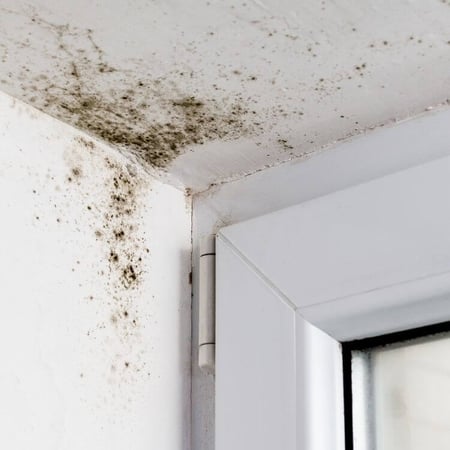 Mold can eat or digest any surface it’s growing on; this can lead to damage to your house or any furnishings in your house. Humidity and dampness in the air of your home can generate an environment that promotes mold growth. According to the EPA, indoor relative humidity (RH), should be kept under 60%, ideally between 30-50%. This will keep your house from being an environment that is friendly to mold because it is not humid enough for their growth. Having functioning, effective humidifier and dehumidifier units in your house will hinder mold growth.
Mold can eat or digest any surface it’s growing on; this can lead to damage to your house or any furnishings in your house. Humidity and dampness in the air of your home can generate an environment that promotes mold growth. According to the EPA, indoor relative humidity (RH), should be kept under 60%, ideally between 30-50%. This will keep your house from being an environment that is friendly to mold because it is not humid enough for their growth. Having functioning, effective humidifier and dehumidifier units in your house will hinder mold growth.
The humidity of your house can be measured with a hygrometer. The hygrometer measures the humidity of an atmosphere according to the EPA-approved measurement relative humidity (RH). If the  hygrometer reads between 30-50%, your humidity is great; in contrast, if it’s too high (over 60%), a dehumidifier is needed to bring the humidity down and prevent mold growth. If the hygrometer reads below 30%, a humidifier is needed to make your house more humid and prevent ticks and other insects from living in your house. It is important to check hygrometer measurements in separate areas of the house. Your living room and basement will likely have different humidities, so it’s important to check other areas of the house to make sure it’s not too humid. The humidifier plays a vital role in preventing mold in a house. If your humidifier is dysfunctional, it can raise the humidity of your house and mold will start growing.
hygrometer reads between 30-50%, your humidity is great; in contrast, if it’s too high (over 60%), a dehumidifier is needed to bring the humidity down and prevent mold growth. If the hygrometer reads below 30%, a humidifier is needed to make your house more humid and prevent ticks and other insects from living in your house. It is important to check hygrometer measurements in separate areas of the house. Your living room and basement will likely have different humidities, so it’s important to check other areas of the house to make sure it’s not too humid. The humidifier plays a vital role in preventing mold in a house. If your humidifier is dysfunctional, it can raise the humidity of your house and mold will start growing.
If you have mold growing in your house, there are several steps you can take to stop and prevent future growth. Effectively using a dehumidifier can quickly halt more mold growth. It is likely that the area that the mold is growing in is . When the dehumidifier removes the humidity from the air, the relative humidity (RH) of the place where the mold was growing will decrease down to healthier levels like 50-60%. After approximately a week or so of keeping the humidity under 60%, no new mold will have grown since the area was moisture-deprived and everything will air out. Additionally with the removed humidity, it will be easier to breathe than before in that area.
Taking care of your humidifier and dehumidifier is essential to preventing mold growth in your house. If your humidifier is dysfunctional, it will not be able to add humidity to your house when it’s too dry. Also, if your dehumidifier isn’t functional, it won’t be able to remove moisture from the air. An overlooked aspect of dehumidifier maintenance is removing the mold from the dehumidifier. When a dehumidifier is removing moisture, mold may get trapped within it. It’s important to make sure to remove any mold or residue from the dehumidifier after use to preserve its functionality. If your current humidifier and dehumidifier aren’t working properly, replacement might be necessary. Talk to our Indoor Air Quality experts today and see if your home has healthy humidity levels. If you would like more information, you can reach Geiler’s Indoor Air Quality experts at 513-574-0025.
Learn more about Indoor Air Quality.


